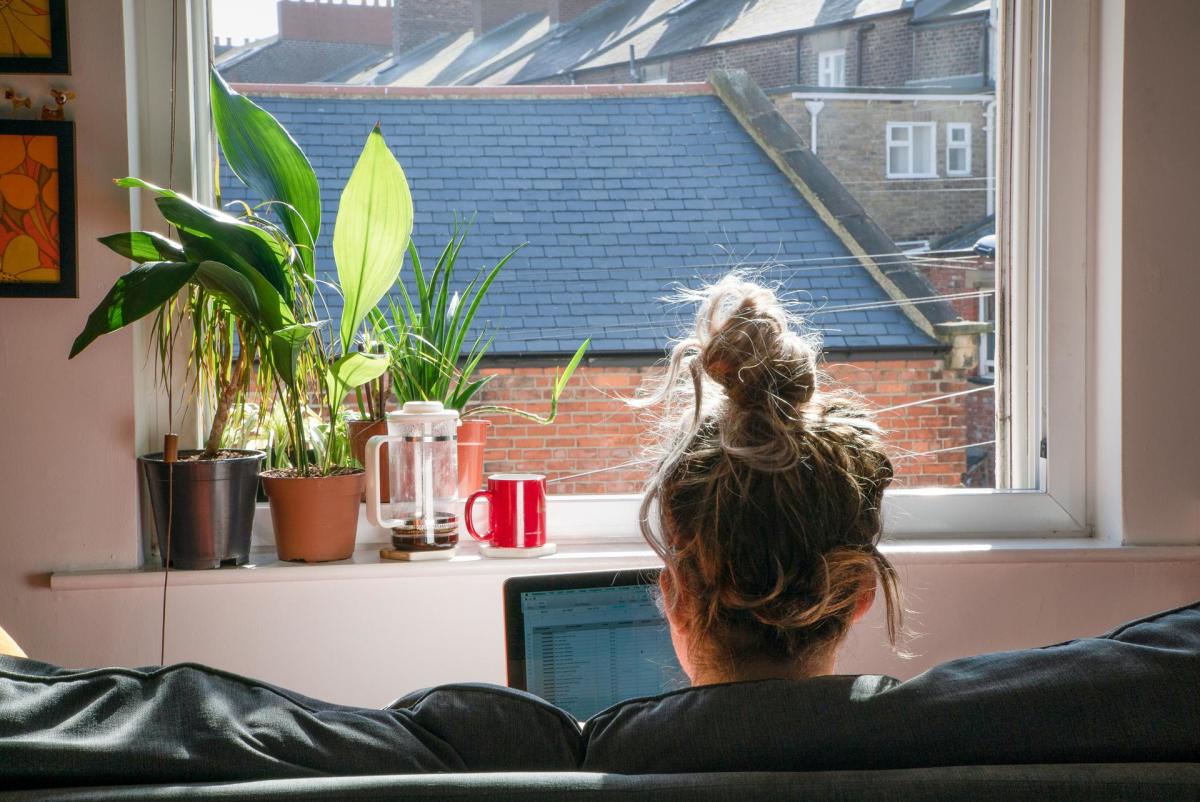7 things renters need to know in 2022
From new Covid-19 measures to rising demand, here’s what you need to be aware of if you’re renting this year.
Are you renting in 2022? Here’s all the news and information you’ll need to know your rights and make the right decisions.
1. New anti-Covid-19 measures
The government has released new guidance to help limit the spread of Covid-19 in rented homes.
It advises renters to make sure your homes are well ventilated if people from outside of your household visit.
This includes landlords, letting agents and workmen.
The guidance suggested keeping windows or doors on opposite sides of a room open during a visit.
Renters should also ensure small vents or grilles at the top of windows are open and unblocked.
You cannot have repairs or safety inspections carried out if someone in your household has Covid-19 symptoms.
The only exception is if the repairs are to fix something that is a direct safety risk to you or the public.
2. Six-month eviction notice rule extended in Wales
In Wales, laws meaning your landlord has to give you six months’ warning if they want to evict you have been extended.
The rule, which was introduced in July 2020 as a result of the Covid-19 pandemic, had been due to expire on 31 December 2021.
But the Welsh Government has now extended it until 24 March 2022.
It applies to all types of evictions, except those involving domestic violence or anti-social behaviour.
3. New energy efficiency rules are on the cards
Renters in England and Wales can look forward to having more energy efficient homes.
The government is expected to press ahead with new energy efficiency rules this year.
The rules state that all rental properties must have an energy performance rating of C or above.
This might mean installing double-glazed windows, a more efficient boiler and additional insulation.
As a result of which, you’ll likely need to spend less on gas and electricity bills.
The only snag is, you might not see much change fast.
The government is expected to give landlords an extra year until 2026 for new rental agreements, and until 2028 for existing ones.
4. It’s easier to have a pet in your home
The government has changed its model tenancy agreement so that landlords can no longer issue blanket bans on pets.
This is good news for all pet-lovers in rental homes.
The change means landlords can only refuse to let you have well-behaved pets if there is a valid reason, such as a lack of space.
The model tenancy agreement is widely used by landlords in England.
It’s important to note that you still need to ask your landlord if you can have a pet.
5. Carbon monoxide safety rules are getting stricter
The government has introduced new carbon monoxide safety rules for rented homes with gas boilers or gas fires.
Landlords must install carbon monoxide detectors. This applies to existing appliances and when new ones are installed.
The detectors must also be fixed or replaced if they are faulty.
The aim is to end accidental carbon monoxide poisoning. Hopefully it will also renters to feel safer in your homes.
6. Renters are getting older
The proportion of people aged between 55 and 64 years old who are renting in the private sector has doubled during the past decade.
There has also been a significant increase in the number of renters aged between 45 and 54, according to the latest English Housing Survey.
The rise in older renters is likely to be due to high property prices making it harder to buy homes, and people divorcing later in life.
7. Increased competition for rental homes in cities
The number of people looking for rental homes in cities is increasing.
But there has been a fall in new properties coming on to the market.
Our latest research found demand is currently 43% higher than the five-year average, but the number of homes available is 43% lower.
The mismatch has led to rent increases hitting a 13-year high.
The typical cost of renting a home across the UK, excluding London, now stands at £809 per month.
Rents outside of London are expected to continue to rise during 2022, to end the year 4.5% higher than they started it.
Key takeaways
- The government has issued new guidance to help stop the spread of Covid-19 in rented homes, as well as new rules making it easier to keep pets in rental homes
- Other laws coming into force this year include changes to energy efficiency standards and tighter carbon monoxide safety rules
- Renters are getting older with the proportion in their mid-50s to 60s having doubled, while high demand and dwindling supply means rents have hit a 13-year high.
Number of first-time buyers hits 20-year high
Record year for first-time buyers stepping onto the ladder, as more than 400,000 buy their first home. The highest number in 20 years.
The number of people taking their first step on the property ladder soared to a 20-year high in 2021.
An estimated 408,379 people bought their first home during the year, 35% more than in 2020, according to Yorkshire Building Society.
It was the first time that first-time buyer numbers have broken through the 400,000 threshold since 2006, while the figure was also more than double the 200,000 people who purchased their first home each year between 2008 and 2012.
First-time buyers accounted for 50% of all people purchasing a property with a mortgage in 2021, up from a low of 36% in 2007 during the global financial crisis.
But numbers still have some way to recover to reach the previous first-time buyer peak seen in 2002, when 531,800 people bought their first home.
Why is this happening?
A combination of high levels of employment and low interest rates have helped to drive the increase in first-time buyer numbers.
There has also been a significant rise in the number of mortgages available for people with only small deposits, after lenders began offering 95% mortgages again.
Many banks and building society pulled the deals in 2020 during the early stages of the Covid-19 pandemic. But the government-backed mortgage guarantee scheme has increased confidence once more.
There are now more than 350 mortgages available to buyers borrowing 95% of their home’s value, while interest rates on these products have fallen to a record low.
At the same time, people purchasing their first home have also benefitted from a raft of government schemes.
Anecdotal evidence also suggests many first-time buyers were able to save more towards a deposit during the pandemic due to decreased expenditure during successive lockdowns.
Who does it affect?
The figures are great news for aspiring first-time buyers as they show mortgage lenders are once again happy to lend to this sector of the market.
They are also good news for people who want to trade up the property ladder.
First-time buyers play a vital role in the market through buying entry-level properties, enabling the owners of these homes to trade up to bigger properties.
What help is available to first-time buyers?
The government’s flagship scheme to help first-time buyers is the Help to Buy equity loan scheme.
It enables people to purchase a new-build property with a 5% deposit, which the government tops up with a 20% equity loan that's interest-free for five years.
Other initiatives include First Homes, under which first-time buyers, key workers and local people, can purchase a home at a 30% discount to its market price, while the 95% mortgage guarantee scheme helps buyers get a mortgage with just a 5% deposit.
There is also help for people saving for a deposit. First-time buyers can take out a Lifetime ISA, into which they can save £4,000 a year, which the government tops up with a 25% bonus, up to a maximum of £1,000 annually.
The money must be used to either purchase a first home or for retirement.
Meanwhile, first-time buyers continue to be exempt from stamp duty on the on the first £300,000 of a purchase on homes costing up to £500,000.
| Property price | Percentage of stamp duty paid |
|---|---|
| £0 - £300,000 | 0% |
| £300,000 - £500,000 | 5% |
| £500,000+ | Normal stamp duty rates apply |
UK homes went up £16,000 in 2021
Homeowners saw thousands added to the value of their homes this year with the entire UK housing stock now estimated to be worth £9.5trn, our latest House Price Index reveals.
UK house prices hit an all-time high in 2021 with the average home rising in value by £16,000.
The increase has left the typical property costing £240,800.
More than half of UK homes have risen in value by more than £15,000.
A whopping 3.5m homeowners will have seen a £30,000 to £44,999 increase in their property’s value.
And, 3.1m homes have soared by more than £45,000.
A surge in home sales in 2021 has resulted in the market value of homes soaring by £670bn collectively.
The entire UK housing stock is now estimated to be worth £9.5trn.
House prices in nearly every region of the country have risen by more this year than in 2019 and 2020 combined.
But, the rate at which property values are increasing is expected to slow next year amid economic headwinds, and a rise in the number of homes being put up for sale - from record low levels
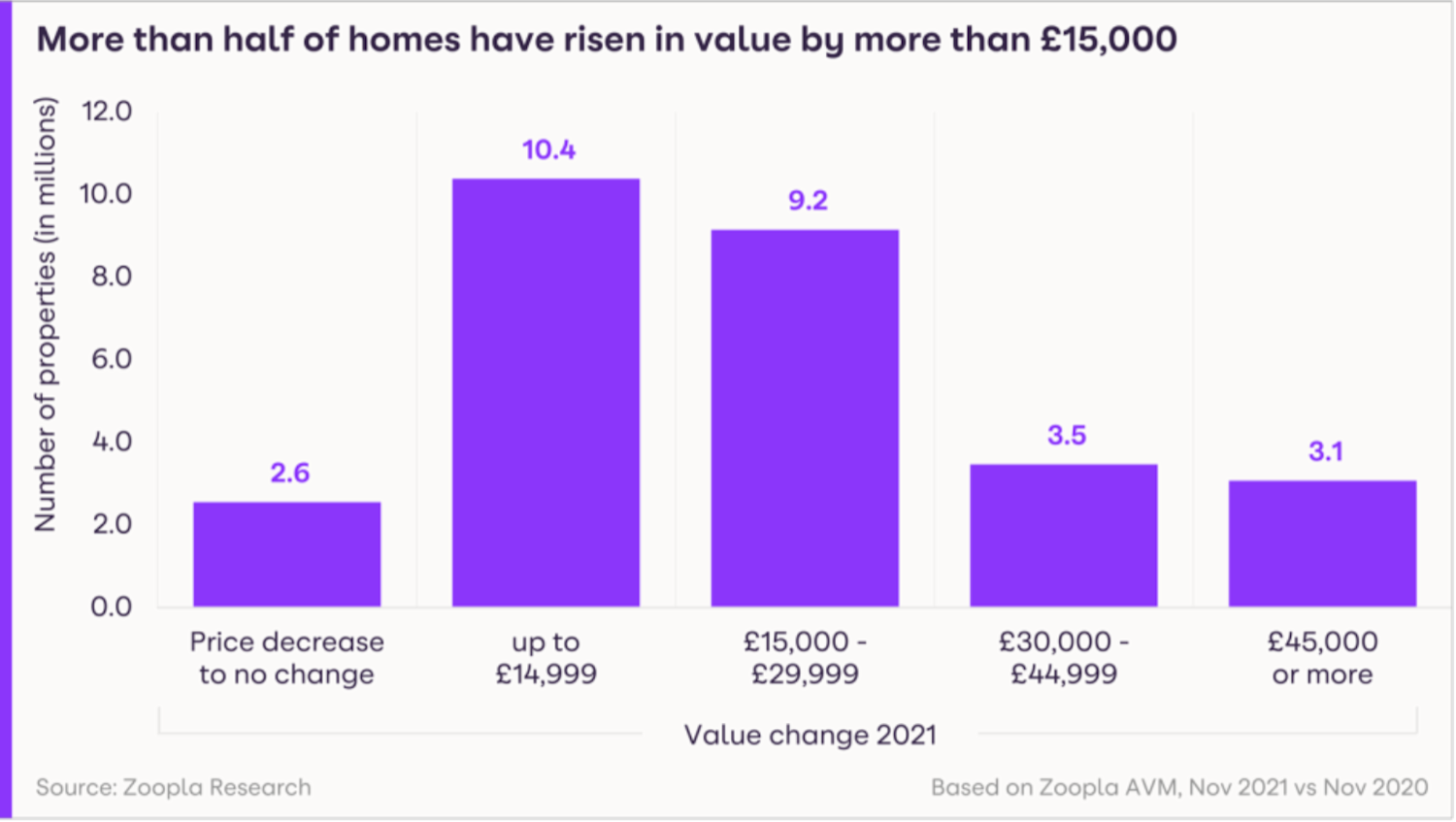
What’s happening to house prices?
House prices rose at an annual rate of 7.1% in November.
The strongest growth was in Wales, where house prices went up 11.1%.
This was followed by the North West at 9.1% and the South West at 8.7%.
By contrast, prices in London edged ahead by just 2.4%.
Northern cities continued to see the highest growth.
Liverpool led the way with growth of 10.7%, followed by Manchester at 8.5% and Nottingham at 8.1%.
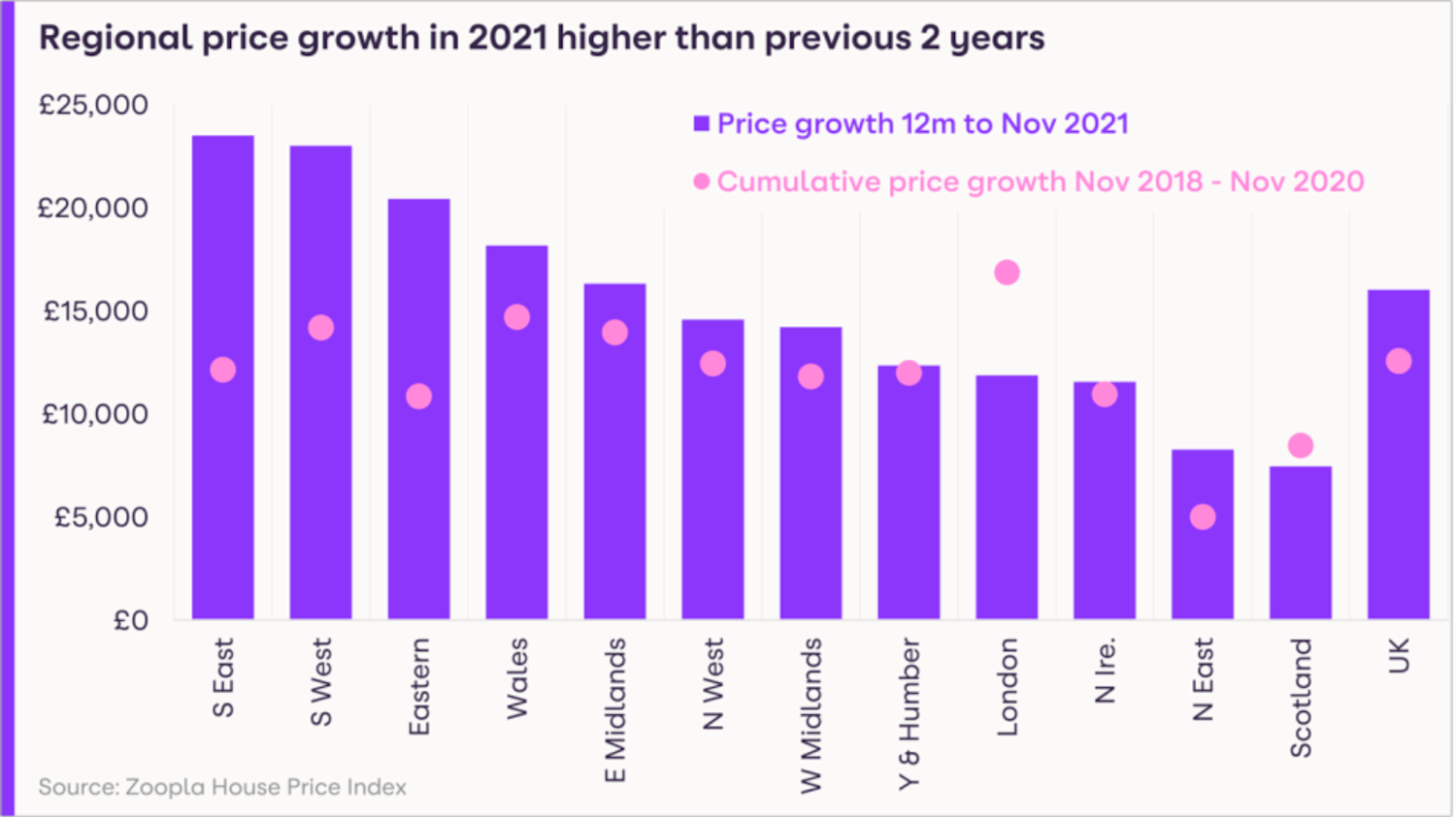
In monetary rather than percentage terms, homeowners in the South East saw the biggest gains.
Homes in the South East went up by an average of £23,500.
While those in the South West typically gained £23,000 and the East of England gained £20,400.
How busy is the housing market?
Buyer demand has remained strong throughout the year, running at an average of 15.7% higher than in 2020.
The number of people looking to move is currently highest in the East Midlands at 42% above last year’s level.
The West Midlands and Yorkshire and the Humber are not far behind at 35% and 28% respectively.
Buyer activity peaked in June 2021, when more people moved home than in any month since our records began in 2005.
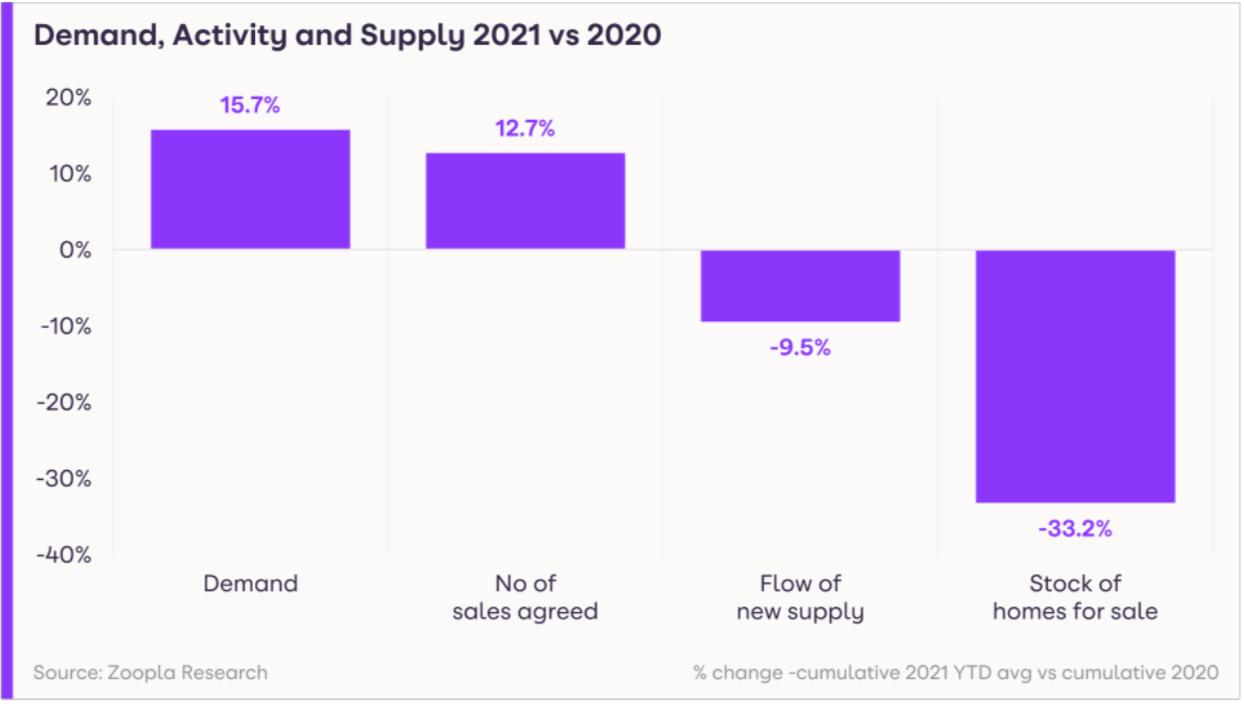
But, the number of homes for sale has failed to keep pace with soaring demand.
The number of properties on the market is around a third lower than it was in 2020.
Strong demand and limited supply has accelerated house price growth in 2021.
What could this mean for you?
First-time buyers
Big jumps in property prices are bad news if you are a first-time buyer, as it makes getting a first home harder.
The good news is that the increase is only an average and the price of houses has increased significantly more than flats.
In fact, the typical price of a flat in London is broadly unchanged since last year.
As a result, if you are struggling to afford your first home, it may be worth looking at flats.
Home-movers
Strong house price gains mean that if you’re an existing homeowner wanting you could be sitting on significant equity.
The shortage of homes on the market also means you are likely to be able to sell your current home quickly, putting you in a strong position to buy.
On the downside, you can expect to face significant competition from other buyers. But this should ease somewhat next year.
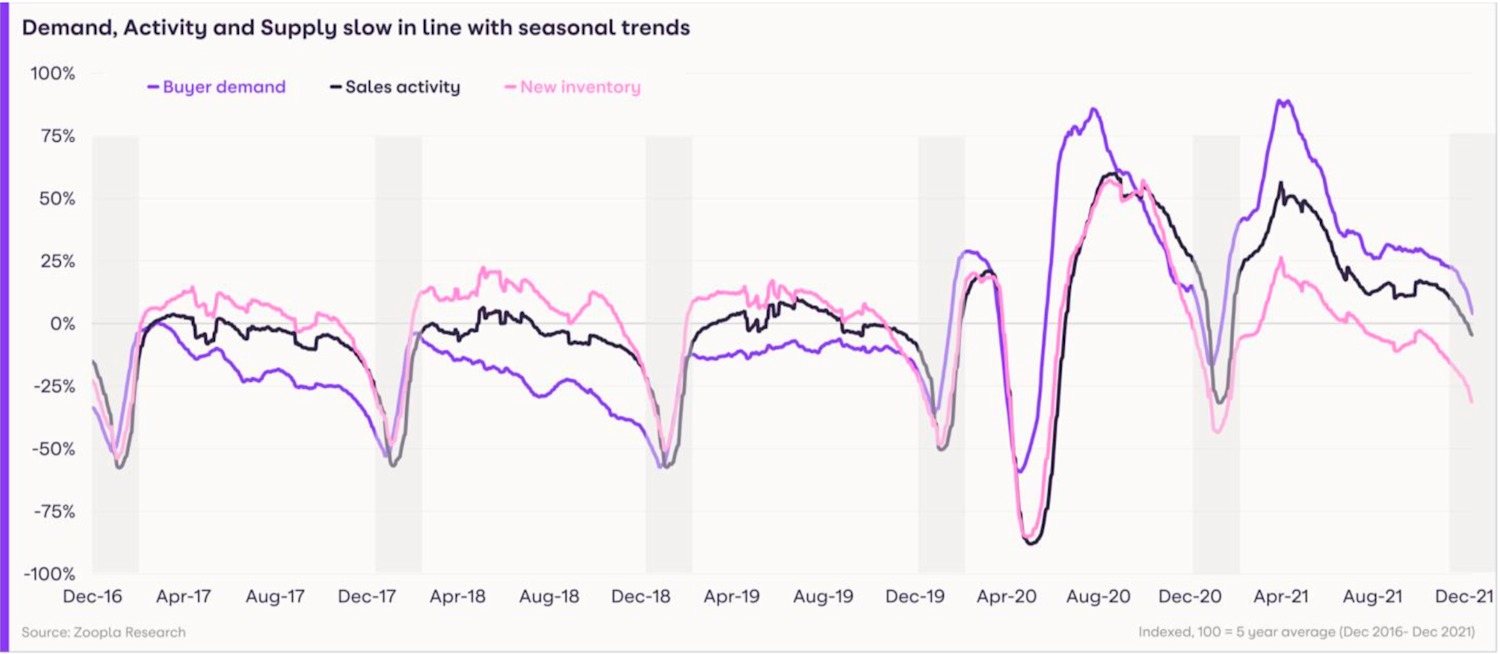
What will happen in the housing market in 2022?
The property market is currently in a seasonal dip, as people put buying plans on hold while they celebrate Christmas.
But, we expect a massive bounce back in activity after the festive season as the pandemic-induced search for space continues.
Our Head of research, said: “This year has been a record year for the market.
“The stamp duty holiday and the pandemic-led ‘search for space’ has resulted in the highest number of sales since before the financial crisis, with 1.5m transactions.”
She expects the strong price growth seen during the past year to prompt some homeowners to cash in and move in the new year.
As a result, more properties are expected to come on to the market in the first quarter of 2021.
As more homes come onto the market, the imbalance between supply and demand should begin to ease.
It currently takes fewer than 30 days on average from a property being listed to a sale being agreed subject to contract.
Sales times are expected to fall back to a pre-pandemic level of 50 days during 2022.
Even so, demand is likely to continue to outpace supply, leading to predicted house price growth of 3% during 2022.
In 2022, we estimate 1.2m homes will be sold, compared with 1.5m in 2021.
Renters spend more on housing costs each month than homeowners
Renters fork out considerably more of their monthly income on their home each month than mortgage-holders, according to the latest English Housing Survey.
Renters face significantly higher housing costs than owner occupiers, according to the latest English Housing Survey.
Private renters spend 31% of their household income on rent each month, while those buying a home with a mortgage spend just 18%.
The English Housing Survey findings for 2020/21 come as our own research shows that rent increases hit a 13-year high.
The cost of renting a UK home outside London, now stands at £809 per month, according to our latest Rental Market Report.
The good news for potential buyers is that there has been a steep increase in the number of people getting on to the property ladder.
The number of first-time buyers in 2020/2021 reached 957,000. That’s over 130,000 more than the previous year.
A total of 61% of people in the private rented sector expect to be able to buy their own home at some point, according to the survey.
Of those, 35% expect to be able to step onto the property ladder within the next two years.
Why are renters paying more?
People in the private rented sector paid an average of £198 a week for their home. While people with a mortgage paid £174 a week.
Part of the discrepancy is caused by the fact that homeowners are currently benefiting from record low mortgage rates.
At the same time, private landlords are facing increased costs due to tax changes and new regulatory requirements. Some of these costs are being passed on to tenants.
Also, private sector rents reflect the current market rate, because rents are typically adjusted when tenants’ contracts are renewed.
Homeowners typically take around 25 years to fully own a property outright if they are buying it with a mortgage.
The owner-occupier figures include people who bought years ago when house prices were lower. This means their mortgage payments are lower than if they were buying today.
How many people are in private rented homes?
One in five people in England rent a home in the private sector, rising to 27% in London.
Younger people are more likely to rent, with 65% of people in the private rented sector aged under 45.
There has been an increase in older age groups who rent.
There are 11% of people aged between 55 to 64 letting in the private sector, double the proportion a decade earlier.
While, the number of people aged between 45 and 54 renting stands at 16%, up from 11% 10 years ago.
How did so many people buy homes this year?
The number of first-time buyers in 2020/2021 reached 957,000. That’s 131,000 more than in 2019/2020.
Many of these buyers will have taken advantage of the stamp duty holiday which ended in June.
The average first-time buyer was 32 when they got on the property ladder, rising to 34 in London, according to the survey.
First-time buyers put down a typical deposit of £44,294, while 62% opted for a mortgage term of 30 years.
The steep increase in first-time buyers is likely to reflect the amount of government support available for those getting on to the property ladder.
What government help is available to first-time buyers?
The Help to Buy equity loan is the flagship scheme which enables first-time buyers to purchase a property with just a 5% deposit.
The government then tops this up with a 20% equity loan, which is interest-free for five years.
In September, the government announced plans to deliver 57,000 affordable homes for first-time buyers to purchase through schemes such as shared ownership.
First-time buyers are also exempt from paying stamp duty on the first £300,000 of a property purchase on a home costing up to £500,000.
Other schemes include First Homes, under which first-time buyers, key workers and local people, can purchase a home at a 30% discount to its market price.
While the 95% mortgage guarantee scheme helps buyers get a mortgage with just a 5% deposit.
First-time buyers can also save for a deposit using the Lifetime ISA, which the government tops up with a 25% bonus of up to £1,000 annually.
Bank of England reveals plan to relax mortgage affordability rules
The suggested affordability changes should make it easier for first-time buyers to get mortgages in 2022.
The Bank of England has announced plans to relax mortgage lending rules.
At the moment, borrowers have to show they’d be able to afford the repayments if their mortgage reverted to their lender's higher variable rate and interest rates jumped 3% .
This test is designed to check buyers could still meet mortgage payments if rates went up.
But the Bank’s Financial Policy Committee (FPC) has decided this affordability rule is no longer needed.
It will consult mortgage lenders and other industry parties early next year about withdrawing the 3% interest rate rule.
The change is likely to offer better mortgage opportunities to first-time buyers.
Why are mortgage affordability rules being eased now?
A number of new affordability guidelines were introduced in 2014.
This idea was to protect the banking system from high levels of household debt following the financial crisis of 2008.
At that time, the FPC recommended that lenders limit the number of mortgages they offered to people borrowing 4.5 times their income.
It also asked lenders to make sure borrowers could afford their mortgage repayments when their fixed-rate deal ended.
This calculation was based on interest rates increasing by 3%, and borrowers being moved on to their lender’s “reversion rate” or higher standard variable rate, which is typically 4.5% or higher.
The reforms were introduced when interest rates were expected to rise to 2.25% in the coming five years.
Today, the Bank of England base rate currently stands at 0.25%.
While interest rates are expected to rise next year, they are likely to do so at a much slower rate than previously expected.
Meanwhile, the FPC has decided other limits on how much banks can lend to people are enough to protect financial stability.
This includes limiting the number of mortgages given to people borrowing a high multiple of their income to just 15%.
Who does the change in mortgage affordability rules affect?
The end of the higher standard variable plus 3% interest rate affordability rule is great news for first-time buyers.
The fact that people buying their first home typically have lower salaries and smaller deposits meant they were more impacted.
For example, a borrower applying for a two-year fixed rate mortgage with interest charged at 1.99%, would have to show they could still afford repayments if the interest rate was 7.5%.
While monthly repayments on a £160,000 mortgage at 1.99% are £682, they would nearly double to £1,196 if the rate was 7.5%.
The rule led to thousands of borrowers being told they could not afford a mortgage, even though they were never likely to face repayments at such high interest rates.
The changes are likely to mean more first-time buyers make it onto the ladder in 2022.
But, the announcement was not all good news for first-time buyers.
The FPC has decided to keep limits in place on the number of high loan-to-income mortgages lenders can provide to borrowers.
Mortgages are getting cheaper for first-time buyers
More good news for first-time buyers is that the average cost of a mortgage for people with only a 5% deposit has fallen to a record low.
The typical cost of a two-year fixed rate mortgage for someone borrowing 95% of their home’s value fell for the eighth month in a row in November to 3.09%.
Meanwhile, the cost of a five-year fixed rate deal dropped to 3.39%.
Both rates are the lowest financial information group Moneyfacts has recorded since records began in 2011.
The number of different mortgages available to all borrowers has reached the highest level since 2008.
Homeowners now have more than 5,300 different deals to choose from.
This includes more than 700 mortgages for borrowers with deposits of 10% or less.
First-time buyers struggled to get a mortgage in 2021
This year saw plenty of first-time buyers have their mortgage applications rejected by banks or building societies.
Only 35% of first-time buyers had their first mortgage application approved in 2021.
This is compared with 48% who were approved first-time in March 2020, according to research by specialist lender Aldermore.
The reasons buyers were turned down for a mortgage included:
- a poor credit history
- administrative errors
- not having a large enough deposit.
- having taken out a payday loan
- being self-employed
- having an irregular income
- a high level of debt.
Buyers surveyed blamed the situation on the Covid-19 pandemic.
Half of those surveyed had experienced disruption to their employment, such as being furloughed or made redundant.
While 2022 looks set to offer more mortgage opportunities, buyers will still need a good credit score.
What else is happening in the mortgage market?
Mortgage lending looks set to reach a record high in 2021.
This is on the back of high levels of housing market activity caused by the pandemic-induced search for space and stamp duty holiday.
Lenders are expected to have advanced a total of £316bn-worth of mortgages during the year.
That’s 31% more than in 2020, according to mortgage industry body UK Finance.
The prediction is in line with our own data that estimates one in every 16 properties will change hands this year.
We’ve seen the busiest property market for 14 years, and the increase in activity has not just been seen among homeowners.
Lending to buy-to-let landlords soared by 83% year-on-year to £18 bn, the UK Finance figures showed.
The private rental sector currently faces a significant mismatch between supply and demand.
A shortage of homes to rent has been putting upward pressure on the cost of renting.
The cost of renting a home in the UK outside of London is now £809 a month on average.
But the increase in buy-to-let lending revealed by UK Finance suggests landlords have been buying more homes this year.
An increase in supply will potentially mean less competition for rentals, which could moderate rental costs.
Interest rates go up for the first time in 3 years
Nearly 2m homeowners will face mortgage repayment increases of around £10 to £15 a month as the Bank Rate rises to 0.25%
The Bank of England has increased interest rates for the first time in more than three years.
The Bank Rate, otherwise known as the official cost of borrowing, has gone up from a record low of 0.1% to 0.25%.
The move by the Monetary Policy Committee (MPC) means nearly 2m homeowners will see their monthly mortgage repayments go up.
The change will add around £14 a month to repayments on a £200,000 mortgage.
But the majority of mortgage-holders will not be affected by the hike as they have fixed-rate loans.
Why are interest rates going up?
Inflation has reached a 10-year high, which is why interest rates are going up.
The MPC can move interest rates up or down to help manage inflation.
Inflation is the rate at which the things we buy are getting more expensive. It is measured by the Consumer Prices Index.
Inflation reached 5.1% in November, more than double the Bank of England’s 2% target.
Raising interest rates helps to cool inflation by making it more expensive to borrow money.
Higher interest rates discourage individuals and businesses from spending, which causes the economy to slow and price rises (inflation) to ease.
Will my mortgage payments go up?
Some mortgages move up and down in line with changes to the Bank Rate.
These mortgages might be tracker deals or the standard variable rates that borrowers revert to once a fixed-rate deal ends.
As a result, any borrowers on one of these home loans are likely to see the cost of their monthly repayments go up. But the increases will not be large.
Mortgage trade body UK Finance estimates the 850,000 people with a tracker mortgage will see their monthly repayments rise by an average of £15.45.
Meanwhile, the 1.1m borrowers on a standard variable rate will face an increase of £9.58 per month.
But the majority of mortgage-holders will not see any change. This is because 74% of mortgage-holders are on fixed rate deals.
Under a fixed-rate deal the interest rate you pay stays the same for the length of the product - typically two or five years.
What’s the wider impact of interest rate rises?
There was some but not a lot of surprise that the Bank Rate went up to 0.25%.
Despite the economic uncertainty created by the omicron variant, the MPC had been expected to raise the official cost of borrowing from its record low level.
As a result, many mortgage lenders had already priced in a possible increase into the interest rates they were offering on new deals.
This, combined with the fact that the Bank Rate only increased by 0.15%, means the cost of new mortgage deals is unlikely to shoot up in the near future.
That said, economists are expecting further rate hikes in 2022, with some predicting the official cost of borrowing could end the year as high as 1%.
Mortgage rates are expected to trend up during the coming 12 months. But strong competition in the market means rates are likely to remain relatively low.
If you’re currently thinking of remortgaging, it makes sense to do so sooner rather than later.
The interest rate increase is expected to have only a very limited impact on the housing market more broadly.
The cost of borrowing is only one of the factors that affects house price growth, and interest rates are still very low by historical standards.
Strong demand from buyers, high levels of employment and a shortage of homes for sale is likely to continue to put upward pressure on property prices.
Revealed: how much parents give their children to help them buy a home
We lift the lid on how hundreds of thousands of grown-up children are set to be handed money to put towards a deposit as a Christmas present this year.
A staggering 64% of parents whose grown-up children own a home have given them money to help them onto the property ladder.
And a further 10% of parents said that while they did not contribute to their children’s house deposit themselves, other relatives did.
Our research shows that parents forked out an average £32,440 to put towards their children's house deposit.
Some parents went even further, with 14% giving their children more than £50,000.
Meanwhile, 11% of parents paid the entire deposit for a new home. And 4% went one step further still and bought a home for their offspring mortgage-free.
Our research was carried out among Zoopla users, nearly 1,100 of whom are parents to grown-up children.
Giving the kids a deposit for Christmas?
Hundreds of thousands of people are set to get some festive cheer this Christmas in the shape of help with a deposit for a new home.
Yes, that's right, 3% of parents with adult children plan to give them money this Christmas to help them onto the property ladder.
But it is not just deposits that parents are dishing out as presents for special occasions.
Nearly one in 10 parents whose grown-up children own a home have given them money for their mortgage as a Christmas or birthday present.
Some 11% of parents have given their children rent as a present.
Here’s what else parents have given their children as a Christmas or birthday present:
- money for bills: 15% of parents
- money for repairs: 13% of parents
- money for decorating: 12% of parents.
Why do parents help their children to buy a home?
Up to 25% of parents helped their children with a deposit for a new home simply because they could afford to do so.
Meanwhile, 24% of parents said their children would never have been able to afford to get onto the property ladder without their help.
Nearly 20% contributed out of guilt or sympathy, believing it to be much harder for their children to buy a new home than it was for them.
What else are parents paying out for?
The so-called 'Bank of Mum and Dad' doesn’t always stop at the deposit.
Up to 17% of parents currently help their adult children with rent or mortgage payments, with 8% doing so every month.
In fact, 36% of parents have helped with their children's rent or mortgage payments at some stage.
What’s more, 11% give their children a regular allowance for home-related expenses, while 28% offer them ad-hoc financial support.
What could our research mean for you?
Our research shows just how few young homeowners have been able to get the keys to their own home independently.
Around three-quarters of buyers had a helping hand financially from family.
Those who managed to ‘go it alone’ and buy a home without parental support are very much in the minority.
Daniel Copley, our consumer expert, explained:
“When looking at the data, it is very clear that average house prices in the UK have increased at a greater rate than salaries over recent decades, reinforcing the notion that it is harder for young adults to get on the property ladder today than it was for previous generations.
“Despite the financial hurdle that a first home purchase can present, our data demonstrates that first-time buyers are prolific in the market and have been for some time.
“Putting more money towards the purchase of a home can help reduce mortgage payments and in turn can unlock lower interest rates, so it’s clear that, when it comes to property, the ‘Bank of Mum and Dad’ will be in business for a long time to come.”
What if the Bank of Mum and Dad can't help out?
The government has a number of initiatives designed to help first-time buyers get onto the property ladder. They include:
- Help to Buy: Equity Loan: offers aspiring homeowners the chance to buy a new-build home with just a 5% deposit
- Shared Ownership: allows buyers to purchase a share of a property and pay rent on the remaining share
- First Homes: helps local first-time buyers and key workers by offering new-build homes at a 30% - 50% discount
- Lifetime ISA: allows first-time buyers to save up to £4,000 a year, with the government adding a 25% bonus
- 95% mortgage guarantee scheme: the government ‘guarantees’ mortgages for buyers with 5% deposits.
Key takeaways
- Nearly two-thirds of parents have helped their children with a deposit for a new home, forking out an average of £32,440
- Some 24% of parents say their children would never have been able to afford to buy a home on their own
- The so-called 'Bank of Mum and Dad' doesn’t stop at deposits, with 36% of parents helping with rent or mortgage payments, too
One in every 16 homes to change hands in 2021
Pent up demand triggered by the pandemic leads to the busiest market for more than a decade as one in every 16 homes is set to be sold to new owners.
One in every 16 privately-owned properties is set to change owners in 2021, making it the busiest year for the housing market since 2007.
The ongoing re-evaluation of homes triggered by the Covid-19 pandemic has continued to drive increased demand throughout the past year.
The high number of buyers in the market, combined with a shortage of properties for sale, has pushed up the average cost of a UK home to £240,000, compared with £200,000 five years ago.
During the past year alone, the typical property has seen £15,500 added to its value, driven in part by buyer appetite for bigger homes, especially in commuter zones and rural areas.
What’s happening to house prices?
House prices rose at an annual rate of 6.9% in October, double the rate of 3.5% recorded in the same month of 2020.
But the figure represents a slight easing in growth compared with the previous two months, and this trend is expected to continue into next year.
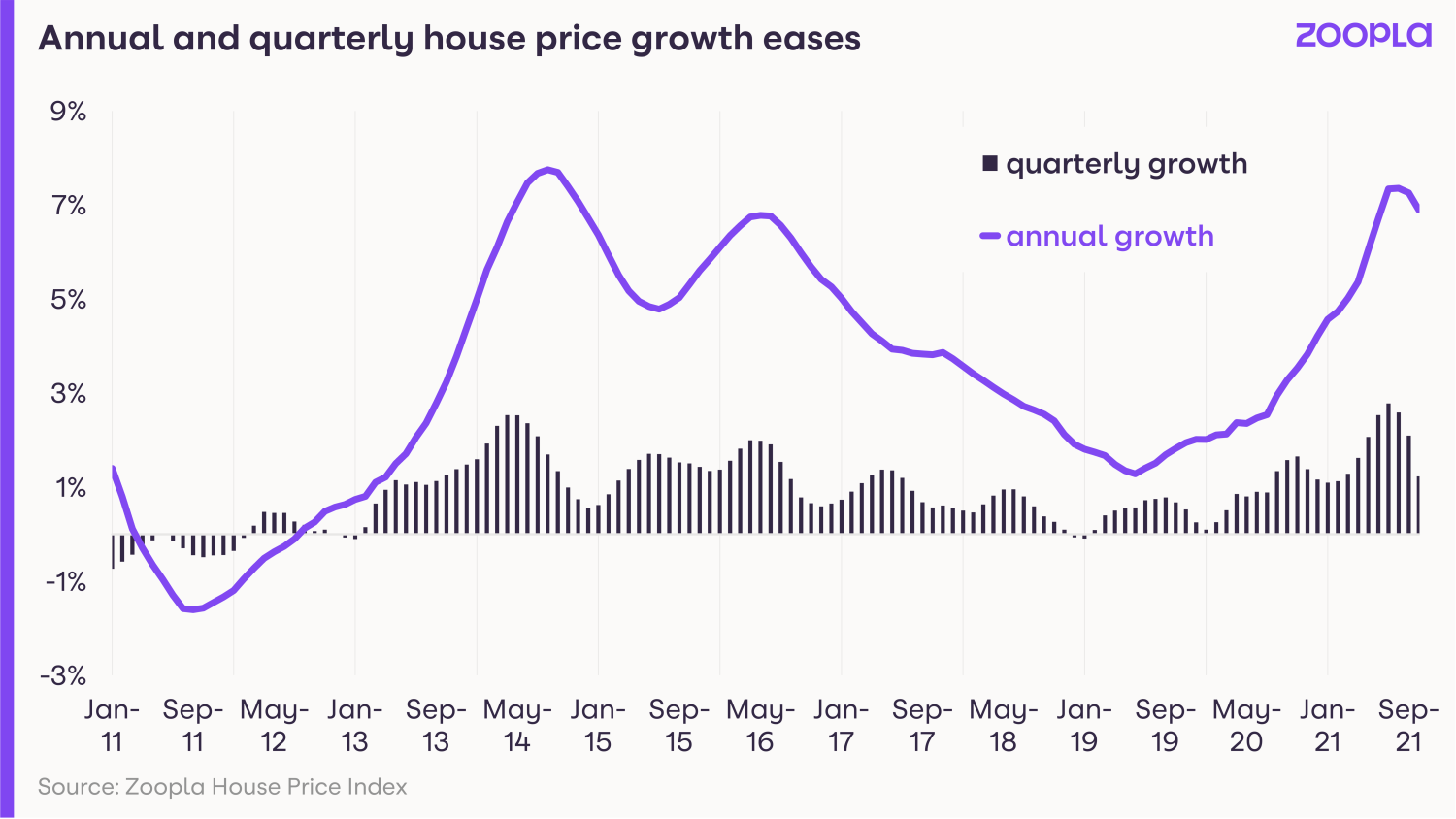
Quarterly figures also suggest the rate of price rises is slowing, with property values increasing by 1.2% in the three months to October, compared with 2.8% in the three months to the end of July.
Wales continued to see the strongest gains, with house prices rising 10.8% year-on-year, followed by the North West at 9%.
At the other end of the scale, London saw the slowest growth of just 2.3%.
On a city level, Liverpool, Manchester and Sheffield, where property remains relatively affordable, posted the highest increases of 10.6%, 8.7% and 7.9% respectively.
Here's how prices have grown in cities over the last quarter
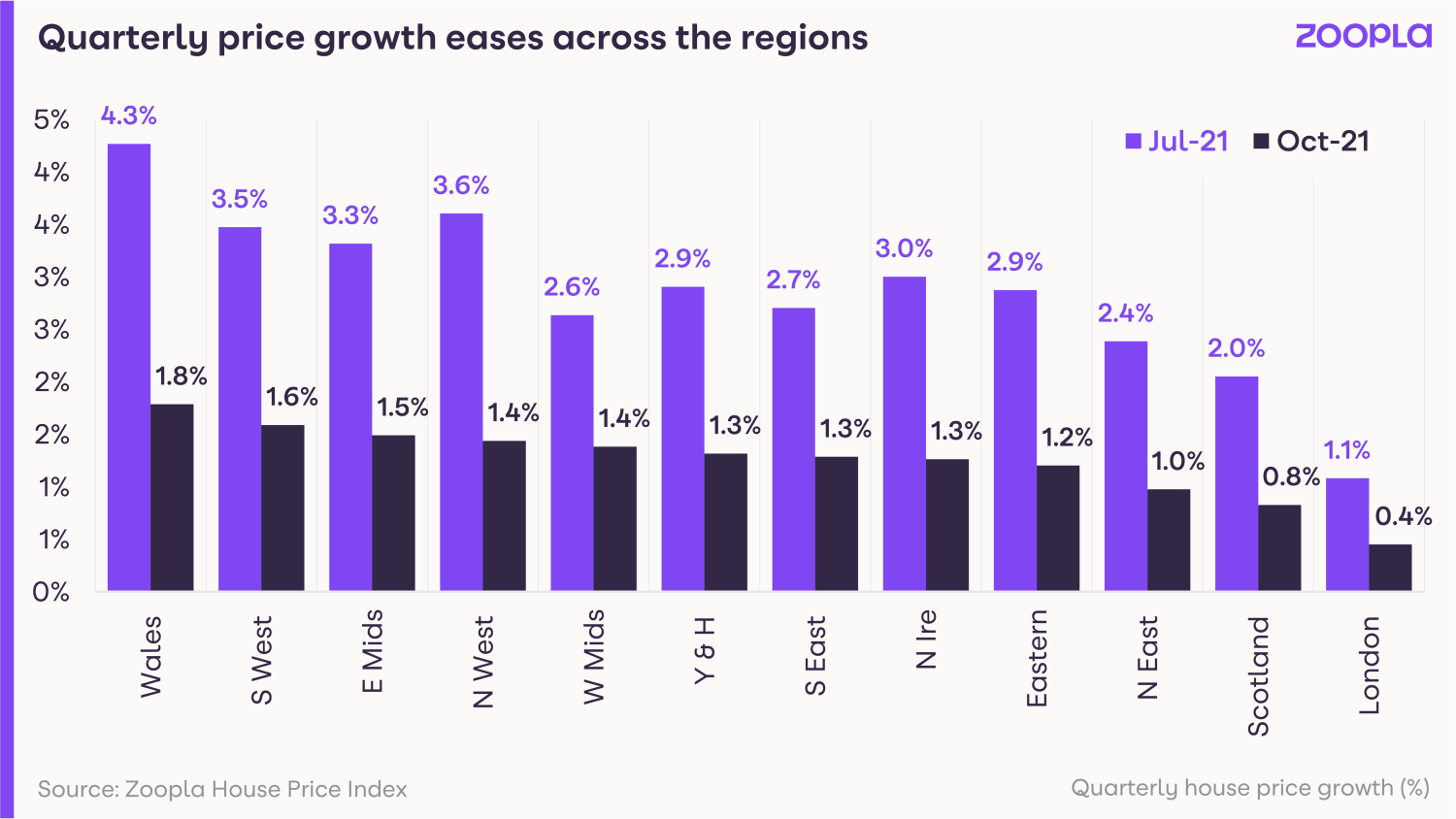
How busy is the housing market?
The property market continues to be busy with buyer demand running 28% above the five-year average.
Unfortunately, this strong demand has not been met by an increase in homes being put up for sale, with the number of properties on the market down 42% compared with the five-year average.
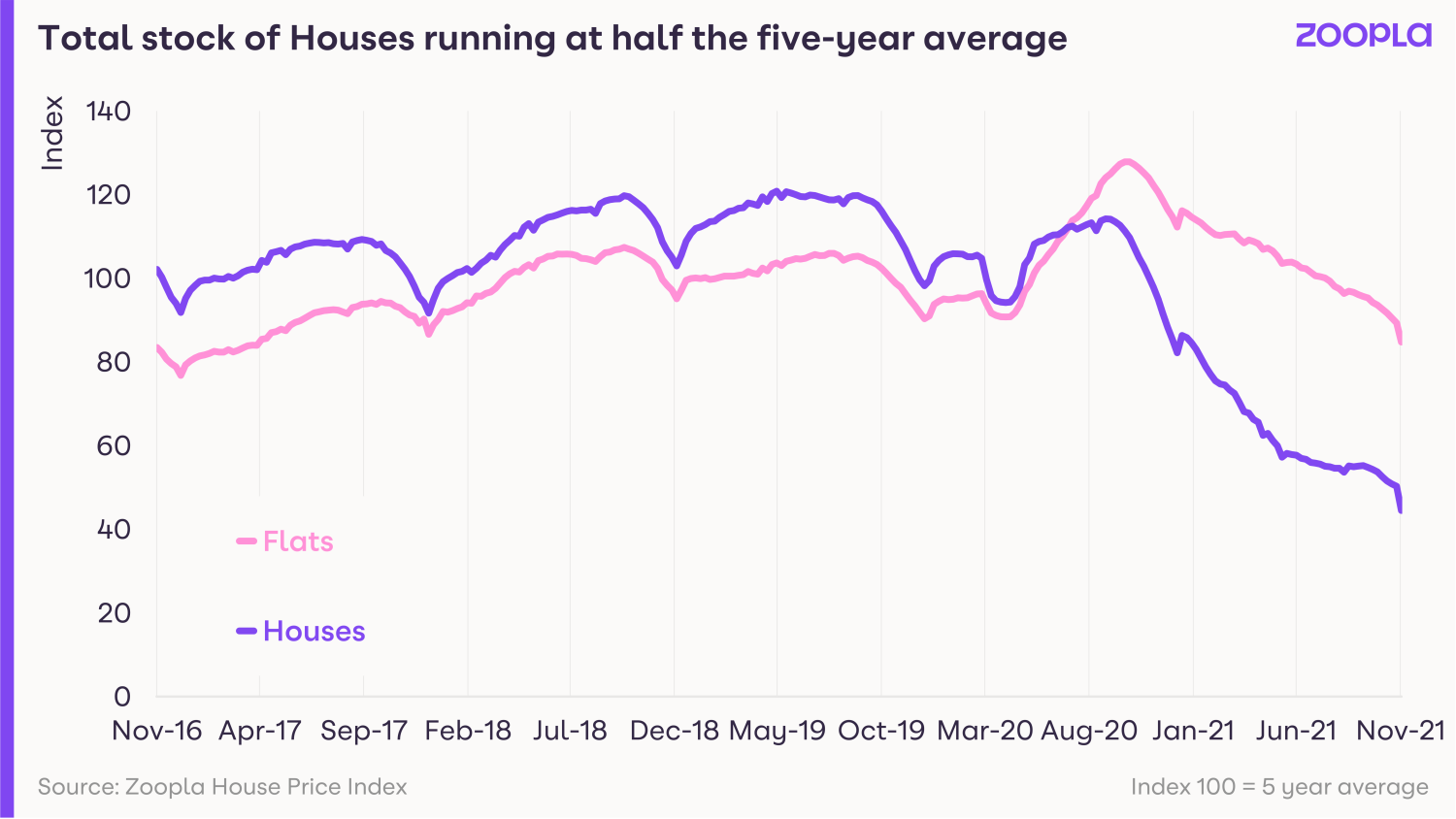
Although there is a shortage of both houses and flats, the number of houses listed for sale is more than 55% down on the five-year average, while flats are down by a more moderate 15%.
This difference in availability is reflected in price growth, with the average cost of all types of houses jumping by 8.3% during the past year, while the typical cost of a flat has risen by a more moderate 1.6%.
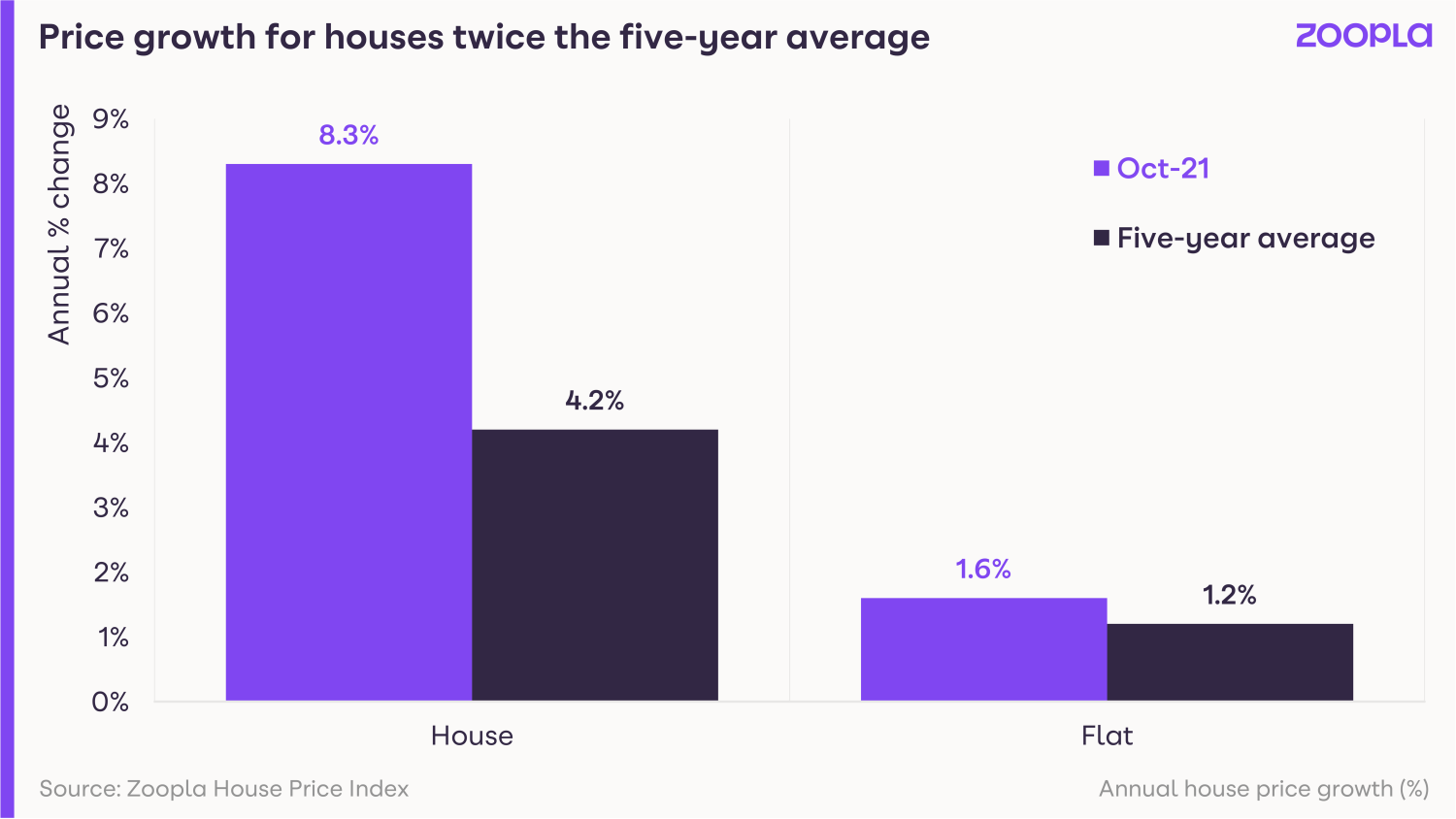
What could this mean for you?
First-time buyers
Intense competition in the market, combined with rising prices, is bad news for first-time buyers.
That said, you can put yourself in a much better position if you're prepared to purchase a flat, rather than a house.
Not only is the shortage of flats for sale less acute than that of houses, but flats have also seen lower price gains in the past year, making them more affordable.
Flats without outdoor space are also taking longer to sell than houses and flats with access to gardens, making this sector of the market less frenzied.
Home-movers
If you have a home you want to sell, particularly if it's a family home or larger house, you're in poll position to obtain both a quick sale and your asking price, as demand for these types of properties remains high.
That said, in the current fast-moving market, co-ordinating your sale with your next purchase could be tricky.
If you do want to sell, you should contact estate agents now to ensure your home is ready to list in January, in time for the New Year rush.
Take the opportunity to get a feel for how fast-paced the market is in your area and how much choice you'll have for your next home. But bear in mind that the market should see a spike in new listings in the New Year.
What will happen in the housing market?
Buyer demand is expected to remain strong going into 2022, but new supply is also likely to come on to the market, as households use the holiday period to make a decision about moving.
The proportion of buyers who are also sellers is expected to increase, helping to ease the shortage of supply.

Grainne Gilmore, head of research at Zoopla, said: “In typical years, the highly seasonal supply of homes being listed for sale slows in the run up to Christmas, but rises sharply in the new year.
“On average, the supply of listings at the end of January runs some 50% higher than the start of December.
“Other factors that will affect prices next year include the looming economic headwinds in the shape of rising inflation – which will push household costs higher.
“Even with some interest-rate rises, mortgage rates are likely to remain relatively low compared to long-run averages, and there is more room for price growth across some of the most affordable housing markets.”
Overall, house prices are expected to rise by 3% in 2022, while around 1.2 million homes are likely to change hands, down from an estimated 1.5 million this year.
UK lender offers 40-year fixed-rate mortgage
The long-term mortgage deal means borrowers will pay the same rate for up to four decades. What are the key advantages and disadvantages?
Buyers now have the option to keep the interest they pay on their mortgage the same for up to 40 years.
Specialist lender Kensington Mortgages has launched a 40-year fixed-rate mortgage.
The deal offers borrowers the chance to pay the same interest rate on their home loan for between 11 and 40 years.
Their interest rate will not change even if the Bank of England increases the official cost of borrowing.
Interest rates are currently at record lows, and buyers who fear the impact of rate rises could benefit from fixing their mortgage now.
The maximum term of a fixed-rate mortgage is usually 10 years.
It is rare in the UK for fixed rate deals to cover the entire “term” of a mortgage, which is usually 25 to 35 years.
“A fixed-rate that covers the entire mortgage term is already very popular in some parts of continental Europe,” said Mark Arnold, CEO of Kensington Mortgages.
“It is likely to become increasingly attractive in a rate-rising environment.”
Why are 40-year fixed mortgages on offer now?
Interest rates are currently at a record low of 0.1%. But the Bank of England is expected to start increasing them in the near future.
If you have a fixed-rate mortgage your repayments stay the same for the product term. The deals typically have terms of two or five years.
Opting for a longer term enables homeowners to benefit from record low rates for longer.
Even so, a term of up to 40 years is highly unusual.
Online broker and lender Habito currently also offers a 40-year fixed rate deal.
A handful of lenders also offer 10-year fixed rate mortgages.
Can I get a 40-year fixed rate mortgage?
One key advantage of the 40-year mortgage is that it judges affordability based on the interest rate the borrower will actually pay.
By contrast, many lenders base affordability on a hypothetical rate if interest rates rise.
As a result, people may be able to borrow more with the Kensington Mortgages product.
What are the disadvantages of a 40-year mortgage?
Borrowers should think carefully before opting for a long-term fixed rate deal.
If you move home during the mortgage term, it should be possible to move the mortgage with you. This is known as “porting”.
But, if you want to pay your mortgage off early, you could face hefty fees.
For example, if you want to leave the mortgage in the first 15 years, you will need to pay a fee worth 7% of the outstanding balance.
The exit penalty gradually falls to 2% of the outstanding debt by year 36.
That said, there are no early redemption penalties if you are selling the property.
Crucially, these fees are also not charged if you are impacted by a critical illness or if the mortgage holder dies.
What else do I need to know about 40-year fixed mortgages?
The Kensingont Mortgage 40-year deal is available to borrowers with deposits of between 40% and 5%.
Interest rates for people fixing for between 36 and 40 years start at 3.34%.
The lowest rate is available to someone with a 40% deposit. This means they are borrowing 60% of their home’s value, and paying a £1,499 arrangement fee.
People with only a 5% deposit will pay a higher rate of 4.16%, if they pay the same arrangement fee.
Lower interest rates are available for people fixing for a shorter period of time.
Rates start at just 2.83% for those fixing for between 11 and 15 years.
Key takeaways
- UK lender Kensington Mortgages has launched a 40-year fixed rate mortgage
- The deal offers borrowers the chance to pay the same interest rate for between 11 and 40 years
- Interest rates for people fixing for between 36 and 40 years start at 3.34%.
Rent increases hit 13-year high as demand in major cities doubles
Rent increases have hit a 13-year high as demand for property doubles in the central zones of major cities. And for the first time in 16 months, London rents are rising.
Rent increases have hit a 13-year high as demand from renters in the central zones of major cities doubles.
The typical cost of renting a home in the UK, excluding London, now stands at £809 per month, according to our latest Rental Market Report.
While renters are returning to cities, the rise in demand is not being met by an increase in the number of homes available to rent, forcing rents higher.
The good news is that despite the increase in rents, affordability has remained largely unchanged thanks to rising pay, with rents accounting for an average of 37% of a single tenant’s monthly income.
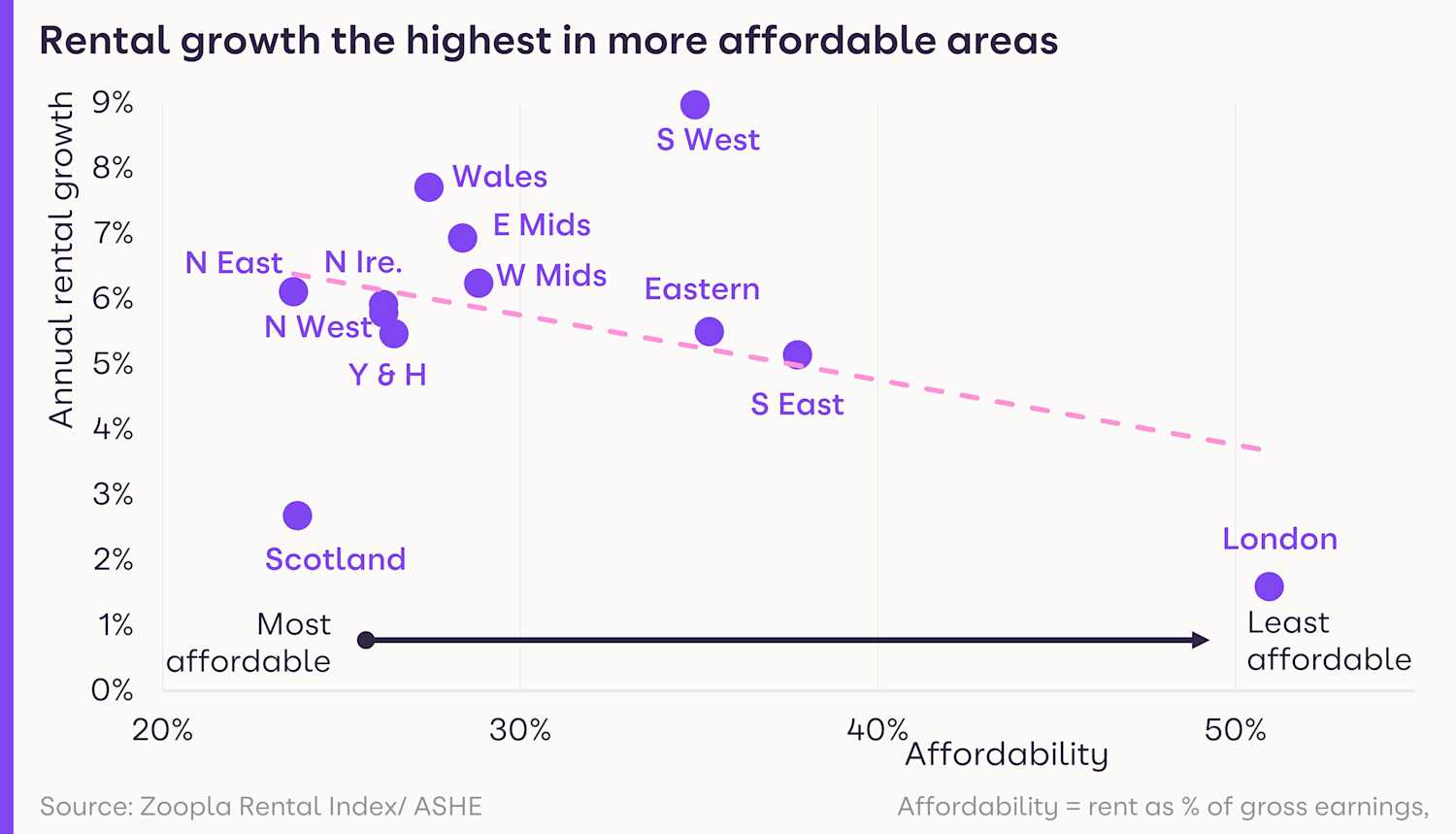
Gráinne Gilmore, head of research at Zoopla, said: “Households looking for the flexibility of rental accommodation, especially students and city workers, are back in the market after consecutive lockdowns affected demand levels in major cities.”
What’s happening to rents?
Average UK rents, excluding London, have risen by 6% during the year to the end of September, jumping by 3% in the past three months alone.
Strong rental growth is being driven by a return of workers to city centres and students to universities.
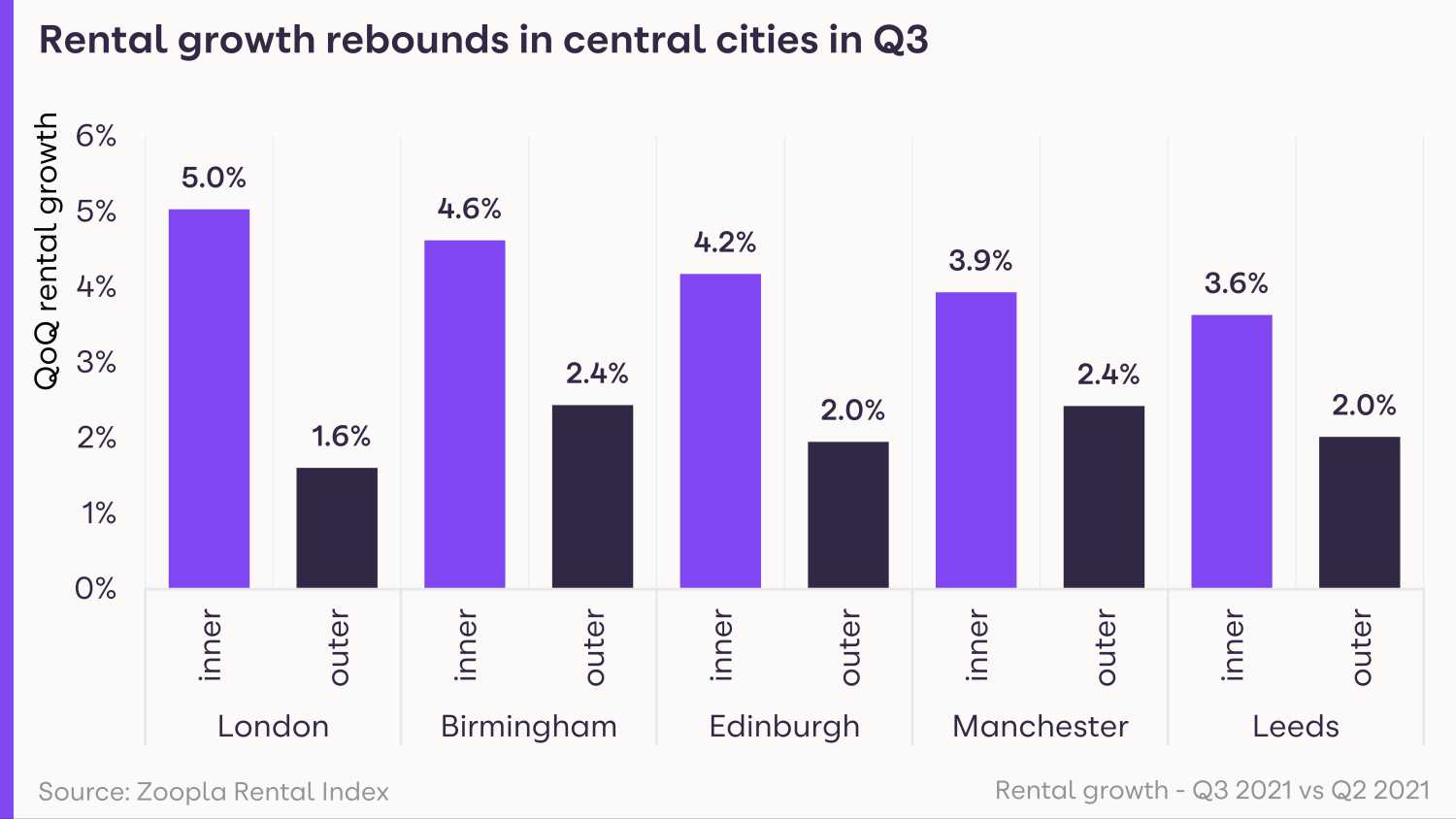
It can also be explained in part by renters opting for larger, and by extension more expensive, properties as part of the pandemic-induced search for space.
The South West saw the biggest jump in rental growth at 9%, due to its popularity as a place to live, followed by regions where renting remains most affordable, namely Wales, where rents have risen 7.7% year-on-year and the East Midlands at 6.9%.
Rent increases are running well ahead of the five-year average in many of the UK’s largest cities, with Bristol seeing the strongest rise of 8.4%, while Nottingham wasn't far behind at 8.3%, and Glasgow was in third place at 7.2%.
Even in London, rents, which had fallen for 15 months in a row, are rising again, increasing by 1.6% in the year to the end of September as offices reopened and city life resumed.
Despite the bounce back, rents in the capital are still 5% lower than they were at the start of the pandemic, following significant falls during the past 18 months.
What’s demand for rental homes like?
Demand in major cities such as Leeds, Manchester, and Edinburgh doubled in the three months to the end of September, compared with the earlier part of the year, as renters rushed back to city centres following the easing of Covid-19 restrictions.

Meanwhile Birmingham has seen a 60% spike and London has seen a 50% jump in demand.
Across the UK as a whole, demand from renters is 43% higher than the five-year average.
The net result is a fast-paced market with homes taking an average of just 15 days to rent across the UK.
Is there a good supply of homes available to rent?
Unfortunately, this increased demand is not being met a rise in the number of homes available to rent, with properties on the market 43% below the five-year average.
The lack of supply is being driven by a combination of long-term factors which have caused landlords to exit the sector, such as the 3% stamp duty surcharge on additional properties, and the post-lockdown spike in demand.
What could this mean for you?
Tenants
If you're looking for a new home to rent, you have two issues to contend with, namely intense competition and rising rents.
You can register with us to receive alerts when a property meeting your criteria becomes available, helping you to stay ahead of the competition.
You may find you're able to get somewhere with a lower rent if you're prepared to compromise on property type, such as opting for a flat rather than a house, or choosing a less central location.
Landlords
If you're a landlord with a property to rent, the dual trend of rising demand and higher rents is good news for you.
The current buoyancy of the rental market may mean it's a good time to think about extending your property portfolio.
But bear in mind that demand patterns have changed compared with during the height of the pandemic, with renters returning to city centre locations.
What’s the outlook?
Looking ahead, the shortage of homes available to rent looks set to continue due to lower levels of investment by landlords.
Meanwhile, demand is also expected to be strong as the employment market remains relatively robust and there is still pent-up demand, particularly for homes in city centres.
This mismatch between supply and demand will continue to push up rents.
Overall, rents across the UK, excluding London, are likely to end 2022 4.5% higher than they started it, while rents in London are likely to rise by 3.5% to exceed their pre-pandemic levels.




